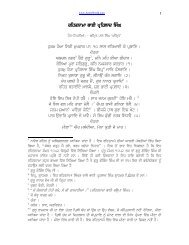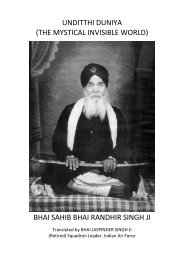Guru Gobind Singh's Death at Nanded Examination of - Vidhia.com
Guru Gobind Singh's Death at Nanded Examination of - Vidhia.com
Guru Gobind Singh's Death at Nanded Examination of - Vidhia.com
You also want an ePaper? Increase the reach of your titles
YUMPU automatically turns print PDFs into web optimized ePapers that Google loves.
32 AN EXAMINATION OF SUCCESSION THEORIES<br />
"they heard <strong>of</strong> <strong>Guru</strong> <strong>Gobind</strong> Singh from a Sikh w<strong>at</strong>chman<br />
and requested him to pray to the <strong>Guru</strong> for their release,<br />
promising to be<strong>com</strong>e Sikhs if the prayer were accepted. And<br />
lo ! in response to the prayer <strong>of</strong> the Sikh, the spirit <strong>of</strong> <strong>Guru</strong><br />
<strong>Gobind</strong> Singh appeared in the fort on horseback. He asked<br />
them to utter Wdhiguru, and their chains and fetters fell <strong>of</strong>f.<br />
He then desired them to hold the stirrups <strong>of</strong> his saddle, and<br />
the two brothers were mysteriously flown away like birds for<br />
twelve kos, some eighteen miles, to the Vindhyachal mountain<br />
where they were freed to go their own way. The <strong>Guru</strong>'s<br />
spirit then disappeared. Here, the distance between S<strong>at</strong>afa<br />
and Vindhyachal is also wrong. Sukha Singh, evidently, had<br />
no idea <strong>of</strong> the distance between the fort <strong>of</strong> S<strong>at</strong>ara and the<br />
Vindhya range which is about two hundred and eighty miles<br />
and not eighteen miles or twelve kos as given by him. In fact,<br />
the whole story is an imagin<strong>at</strong>ive concoction.<br />
In reply to an enquiry made by the author, Pr<strong>of</strong>essor<br />
Ganesh H. Khare, the well known scholar <strong>of</strong> Mar<strong>at</strong>ha history<br />
and Cur<strong>at</strong>or <strong>of</strong> the Bhar<strong>at</strong>a Itihasa Samshodhaka Mandala,<br />
Poona, writes in his letter <strong>of</strong> October 10, 1971: "As far as my<br />
reading <strong>of</strong> the Mar<strong>at</strong>ha history goes, I have not <strong>com</strong>e across<br />
the reference to brothers Balarao and Rustamrao escaping from<br />
the S<strong>at</strong>ara fort." Shri V. A. Kanole, the eminent research<br />
scholar in the history <strong>of</strong> Maharashtra and Honorary Secretary<br />
<strong>of</strong> the God<strong>at</strong>eer Itihas Samshodhan Mandal, <strong>Nanded</strong>, has<br />
also not been able to trace any mention <strong>of</strong> the Balarao-<br />
Rustamrao incident in any work on the history <strong>of</strong> the<br />
Mar<strong>at</strong>has. In the absence <strong>of</strong> any reference to it in the Mar<strong>at</strong>ha<br />
history, the story <strong>of</strong> the mysterious escape <strong>of</strong> the Mar<strong>at</strong>ha<br />
brothers <strong>of</strong> Janwara from the fort <strong>of</strong> S<strong>at</strong>ara with the help <strong>of</strong><br />
(the spirit <strong>of</strong>) <strong>Guru</strong> <strong>Gobind</strong> Singh tumbles down as fictitious<br />
having no historical basis to support it.<br />
Wh<strong>at</strong>ever the credulous believer in supern<strong>at</strong>uralism<br />
might say in explaining such fables, they are unn<strong>at</strong>ural<br />
on the face <strong>of</strong> them and cannot be accepted as historical<br />
events happening with men living in this world in flesh and<br />
blood. And if any pretender hopes to build up a case for his<br />
GURU GOBIND SINGH S DEATH AT NANDED<br />
pretensions on such fictitious or supern<strong>at</strong>ural fables, he is only<br />
deceiving himself.<br />
The account <strong>of</strong> the de<strong>at</strong>h <strong>of</strong> <strong>Guru</strong> <strong>Gobind</strong> Singh as<br />
given in sakhl 27 <strong>of</strong> Sakhian P<strong>at</strong>shahl Das chapter <strong>of</strong> the<br />
Mehma Prakash by Sarup Das Bhalla, pp.891-93, may on the<br />
whole be said to be nearest the truth and may be accepted as<br />
objective and historical. Written by a descendant <strong>of</strong> <strong>Guru</strong><br />
Amar Das and based, apparently, on reliable evidence, it was<br />
<strong>com</strong>pleted in January 1801. The manuscpript referred to by<br />
Bawa Sumer Singh in his Pothi Gur-bilas ki, p. 713, was<br />
written in 1774(1831 Bikrami). The first part <strong>of</strong> the chapter<br />
regarding the excitement to the P<strong>at</strong>han who <strong>at</strong>tacked and wounded<br />
the <strong>Guru</strong> seems to have <strong>com</strong>e from earlier writers. But<br />
the second part is based entirely on independent evidence. In<br />
the absence <strong>of</strong> any poetical embellishment and unn<strong>at</strong>ural, mysterious<br />
or supern<strong>at</strong>ural element introduced into it, the account •<br />
may be accepted as historicaly correct.<br />
According to the Mehma Prakash : -\<br />
When the <strong>Guru</strong> took the bow in his hand and wished to pull<br />
it, the Sikhs submitted th<strong>at</strong> the wound had not yet <strong>com</strong>pletely<br />
healed. The <strong>Guru</strong> said th<strong>at</strong> there was no cause for fear.<br />
He then pulled the bow, and the stitches gave way. At this<br />
time the <strong>Guru</strong> said th<strong>at</strong> the time for his de<strong>at</strong>h had <strong>com</strong>e. He<br />
called the Sikhs to his presence and he was pleased to see<br />
them. The Sikhs then asked him where they would have the<br />
darshan [<strong>of</strong> the <strong>Guru</strong>]. The Gre<strong>at</strong> <strong>Guru</strong>, merciful to the lowly,<br />
said: "Our Ten forms have <strong>com</strong>e to end. Now recognize<br />
the <strong>Guru</strong> Granth Sahib in my place. He who wishes to talk to<br />
me should read the Adi Granth Sahib. This will be like talking<br />
to me.I have entrusted you to the lap <strong>of</strong> the Almighty."<br />
Having said this, he desired them to prepare the biban (the<br />
wooden board to carry the dead body to the crem<strong>at</strong>ion<br />
ground). After this was done, he lay down and covered<br />
himself with a sheet''and liber<strong>at</strong>ed himself from human existence<br />
(or merged himself in the Divinity). Neither did he<br />
<strong>com</strong>e anywhere nor did he go anywhere. Seeing this spectacle<br />
all people fully believed th<strong>at</strong> the Gre<strong>at</strong> <strong>Guru</strong> was a part <strong>of</strong><br />
the Divine Light. The <strong>Guru</strong>'s body was then crem<strong>at</strong>ed and<br />
the Sri <strong>Guru</strong> Granth was recognized.in place <strong>of</strong> the <strong>Guru</strong>.<br />
[Appendix VII.]<br />
33




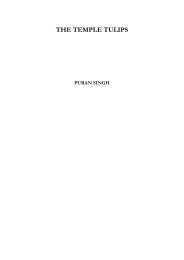
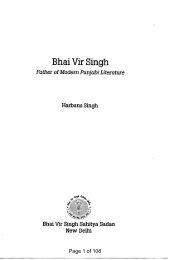

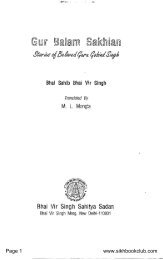
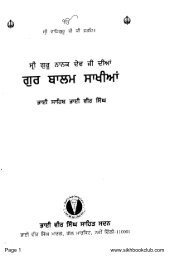
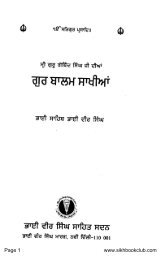
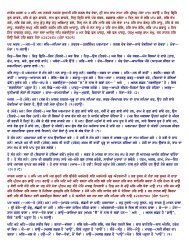
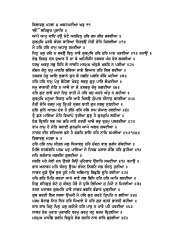

![cOpeI ] hmrI kro hwQ dY r~Cw ] pUrn hoie ic~q kI ie ... - Vidhia.com](https://img.yumpu.com/12240258/1/190x245/copei-hmri-kro-hwq-dy-rcw-purn-hoie-icq-ki-ie-vidhiacom.jpg?quality=85)
